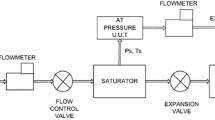Abstract
Flow-through radon sources were widely utilized in the calibration of radon equipment and radon studies. In this paper a broken 266Ra source which was made in 1983 by the Pylon Inc. was modified to a new flow-through radon source. The humidity and flow rate dependence of the new flow-through radon source was studied to get a reliable large-scale radon source. The results show that the equilibrium radon concentration of the new flow-through radon source is rather sensitive to flow rate, especially below 1 L/min of flow rate, which sharply decreases with the flow rate rising, however, it increases with the relative humidity rising. The radon emanation coefficient does not depend on the flow rate of 0.6–2.57 L/min. However, the radon emanation coefficient increases up exponentially with the rising of the air humidity, it increases up slowly at the relative humidity of 4–50%, but it does fast at the relative humidity of 60–85%. The humidity dependence of flow-through radon sources is more obvious than diffusion radon sources because a dominative radon transport mode from the solid source material into the air is seepage rather than diffusion.







Similar content being viewed by others
References
World Health Organization (2009) WHO handbook on indoor radon: a public health perspective. ISBN: 978-92-4-154767-3.
Strong JC, Walsh M (1990) Indoor radon and lung cancer: reality or myth. In: The 29th Hanford symposium on health and the environment, p 731
Sakamoto S, Ishimori Y, Maruob Y (2005) Development of a radon standard source. Nucl Instrum Methods Phys Res A 545:516–523
Qiu S (2006) Calibration of a 220Rn flow-through source. Radiat Environ Biophys 45:25–220
Fukutsu K, Yamada Y (2013) Development of radon sources with a high stability and a wide range. Rev Sci Instrum 84:1–5
Rolle R, Gründel M, Schulz R, Porstendörfer J (2005) Characterization of thoron and radon flow-through sources. Radioact Environ 7:1569–4860
Ishikawa T, Hosoda M, Sorimachi A, Tokonami S, Katoh S, Ogashiwa S (2011) Radiological characterization of commercially available‘‘radon spa sources’’. Radioanal Nucl Chem 287:709–713
Kotrappa P, Stieff LR, Volkovitsky P (2005) Radon monitor calibration using NIST radon emanation standards: steady flow method. Radiat Prot Dosim 113(1):70–74
Sun H, Furbish DJ (1995) Moisture content effect on radon emanation in porous media. J Contam Hydrol 18:239–255
Yu KN, Koo VSY, Guan ZJ (2002) A simple and versatile 222Rn/220Rn exposure chamber. Nucl Instrum Methods A481:749–755
Pooya SMH, Taheri M (2013) A calibration setting with uncertainty measurements for passive/active radon monitors using flow-through source type. Appl Radiat Isot 73:49–51
Stranden E, Kolstad AK, Lind B (1984) The influence of moisture and temperature on radon exhalation. Radiat Prot Dosim 7(55):1–4
Markkanen M, Arvela H (1992) Radon emanation from soils. RadiatProtDosim 45(269):1–4
Menetrez MY, Mosley RB, Snoddy R, Brubaker SA Jr (1996) Evaluation of radon emanation from soil with varying moisture content in a soil chamber. Environ Int 22:447
Zhuo W, Iida T, Furukawa M (2006) Modeling radon flux density from the earth’s surface. J Nucl Sci Technol 43(4):479–482
PYLON Instruction Manual (1998) Model 2000 passive radon gas source. PYLON Electronic Development Company, Canada
Tanner AB (1980) Radon migration in the ground: a supplementary review. In: Proceedings of 3rd international symposium on natural radiation environment, Houston, Texas, April 23–28, 1978, vol 1, p E-5
Iskandar D, Yamazawa H, Iida T (2004) Quantification of the dependency of radon emanation power on soil temperature. Appl Radiat Isot 60:971
Sorimachi A, Sahoo SK, Tokonami S (2009) Generation and control of thoron emanated from lantern mantles. Rev Sci Instrum 80:1–4
Acknowledgements
This work was funded by the Consortium for Verification Technology under the USA Department of Energy National Nuclear Security Administration, Award No. DE-NA0002534. This work was partially supported by the Project of Nuclear and Radiation Safety Supervision under the China Department of Environmental Protection (Grant Nos. DC1606 and DC201704), the State Scholarship Fund of China (File No. 201608430242), the Doctor Fund of the University of South China and the Natural Science Foundation of Hunan Province (Grant No. 2017JJ3267).
Author information
Authors and Affiliations
Corresponding author
Additional information
Publisher's Note
Springer Nature remains neutral with regard to jurisdictional claims in published maps and institutional affiliations.
Rights and permissions
About this article
Cite this article
Zhou, Q., Shubayr, N., Carmona, M. et al. Experimental study of dependence on humidity and flow rate for a modified flowthrough radon source. J Radioanal Nucl Chem 324, 673–680 (2020). https://doi.org/10.1007/s10967-020-07081-0
Received:
Published:
Issue Date:
DOI: https://doi.org/10.1007/s10967-020-07081-0




